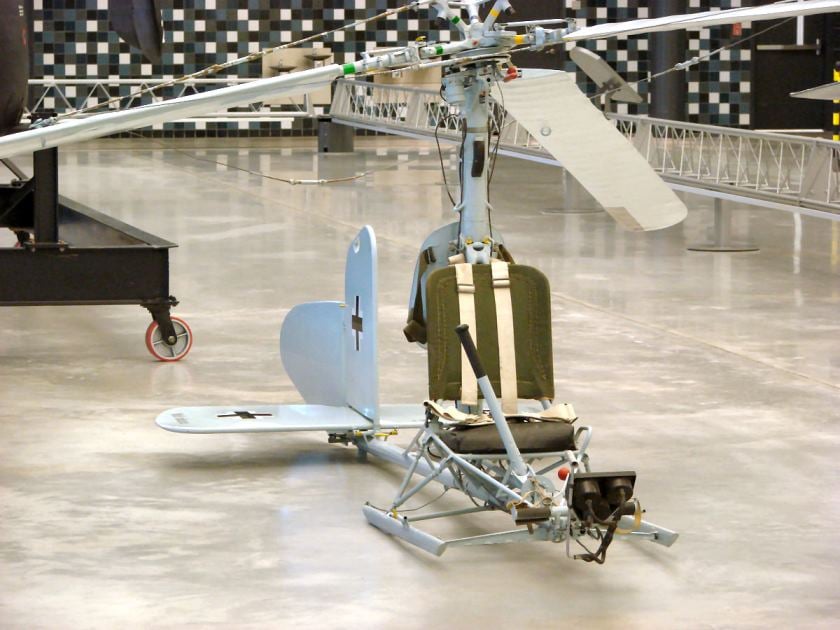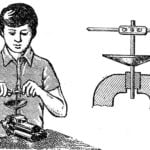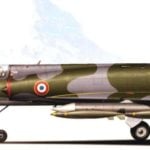 The first and most important work on the rotating propeller to generate lift forces were made in the period between the world wars. Thus, it was found that the spinning rotor can generate lift force, maintaining its rotation from the incoming flow. Any drive to the rotor in this case was not needed. This mode is called “autorotation”. Its use allowed the Spanish designer Juan de La Cierva to invent the autogyro.
The first and most important work on the rotating propeller to generate lift forces were made in the period between the world wars. Thus, it was found that the spinning rotor can generate lift force, maintaining its rotation from the incoming flow. Any drive to the rotor in this case was not needed. This mode is called “autorotation”. Its use allowed the Spanish designer Juan de La Cierva to invent the autogyro.
The gyro was a pioneer and non-trivial invention. He had the main rotor, which was hyped before launch from an external drive. Then use a pulling propeller began moving sideways. This flow was further promotion of the rotor. When the lifting force has reached a sufficient size, was carried off.
A distinctive feature of gyroplanes are short takeoff and landing capability, the ability to fly at low speeds and the possibility of a vertical landing. The gyros was built and used in 20 – 30 years of XX century, and knowledge gained during their development, served as the Foundation for the creation of the helicopter.
As for the subject of this article – gyroplane Fa-330, it attracts attention for several reasons. First, it is one of the few aircraft used aboard a submarine.
Second, the simplicity and elegance of design cannot fail to arouse admiration even in our days. And, thirdly, it is the only autogyro produced serially and applied (how successfully is another question) in the Second world war.

Fa-330 front view, bottom (hanging from the ceiling)

Instrumentation “Wagtails”: altimeter, air speed indicator and tachometer (indicates rpm of the rotor)
In Germany, during the war, the gyroplane takes the designer Heinrich Focke, who worked at the factory Focke-Achgelis. It was originally developed gyroplanes-gliders for landing Marines on platforms of limited size. The most successful design was the Fa-225, which had a fuselage from a standard glider DFS 230, and instead of the wings – the rotor. Non-motorized apparatus was supposed to be towed to the landing area where the tug is unhooked, and the autogyro landed in autorotation. The car was intensively tested in 1942, but due to a number of causes adopted was not accepted.
After analyzing the deficiencies with the Fa-225, the air Ministry put forward a new concept of using gliders gyroplanes. These non-motorized devices might autorotation to be in the air and perform a vertical landing at low speed. These qualities fit to perform watch service on Navy ships. The Kriegsmarine issued a brief of requirements for a small aircraft, can be launched from the deck of the submarine, and then fly her in tow. It needs to be easy to maneuvers that ordinary sailors could lift him into the air, and have a small size to post on PL.

The development requested by the plant “Focke-Achgelis” as having relevant experience and compensation for refusal from the Fa-225. The original project was called Bachstelze “Wagtail” and later received the official designation of the Fa-330.
It should be noted that the first field of view from a submarine of the German sailors tried to increase with the lifting of the mast with observation platform on its top. But after several experiments it became clear that mast plays gyro. It is heavier setup is comparable to the build time of a gyroplane.
And the height of the observer is not necessary to argue the gyroplane it is much more. The only advantage of the mast – it does not require airtight containers for its storage. But, on the other hand, in a submerged position when the mast is laid along the deck, she created additional resistance. The container for the gyro built into the superstructure just below the top deck.
The basis of the Fa-330 was serving spatial farm, main welded from metal pipes and backed up by an auxiliary tube of smaller diameter. On the tail of the fuselage the tail was attached, consisting of a fixed stabilizer, fin and rudder. The plane was detachable and had a metal frame covered with canvas. To the middle part of the fuselage, at the hinge, is attached to a vertical pipe stand for mounting of the rotor.

Fa-330 with pilot is blown in the wind tunnel, Golis MEUDON

Fa-330 in flight testing, climb he could with the help of glider winches. (Pictured right)

To take off from land applied easy removable chassis

Testing of “Wagtails” on the submarine. Wooden stand on which the Fa-330, is unlikely to be standard equipment of the submarine. In the foreground is the winch

For takeoff the Fa-330 was used in place of the fence cutting a submarine. Winch installed on the deck in the nose. U-boat U-523
Stand was recorded with the aid of additional brace to the back of the chair. The rack is attached to a special cradle to accommodate a parachute, and the top – bracket of the rotor hub. In front of the bar on the frame of the fuselage, is rigidly mounted a Cup seat. In front of the seat was the classic controls – knob and pedals, and mounted the bracket – dashboard. The chassis consisted of two skis, made from tapered tubes that were attached to the fuselage by removable struts.
The rotor consisted of a hub and three blades. The blade had a mixed design with metal tubular spar. Before the promotion of blades supported by rope rigging, which did not allow them to fall to the deck. The rotor hub was attached to the rack with a special bracket that allowed her to deviate in the longitudinal plane. Control was made from the handle through cable wiring. In the sleeve housed bearings, hand brake and a special pulley, which served as pre-promotion of the rotor. For this it wound the twine, which at the right moment, pulled a few people. The string unwound and the rotor started moving.
On some gyros the system is perfected – mounted electric starter. When you start the initial rotation of the rotor given by hand, and then turn on the motor from the boat the source of energy, which spin the rotor up to the necessary speed. The need for multiple launch command is eliminated. The brakes were used to stop the rotor after landing, or to reduce speed in flight.
The equipment of the gyroplane as simple as possible. It consisted of a tube of the PST, the data from which are displayed at the pointer speed and altitude. Another instrument was a tachometer that indicates the speed of the rotor. The totality of this evidence allowed the pilot to withstand the specified flight mode. Using the phone to communicate with Board the submarine and passed the results of observations. The empty weight of the unit was 75 kg and the maximum take-off weight is 175 kg. the length of the gyro – 4,47 m, height – 1,67 m, a rotor diameter of 7.3 m.
When disassembling the gyro stabilizer and fin was shot. Then disconnect the strut of the rack. The seat back and front were laid forward along the fuselage. Of the blade when it fell down and also was located along the fuselage. Skiing was shot and the struts are formed. Submarine apparatus was stored in three sealed containers – one large and two small horizontal-vertical. Disassembly – Assembly of the machine required the work of three people for 5-10 minutes.
The small size of the gyro made it possible to examine its full-scale sample in a large wind tunnel in Golis MEUDON in France. Investigations revealed problems with stability in air have been solved by modifications of joints and strengthening of blades.

Fa-330 – front view

Fa-330 — side, clearly visible tail and pack with a parachute

Fa-330 – view from below. Rate the openwork design of the gyroplane.
Test Fa-330 was carried out in 1943 After confirming the possibility of using the gyro in the Navy began its mass production. It was built about 110 pieces Fa-330, of which about 60 were installed in submarines of IX series. For pilot training have formed a special squadron. The takeoff was performed from the back of speeding truck, which was carried out and the subsequent tow. In the presence of wind, the gyro can be run as a glider with a winch. To improve the safety of these flights on the chassis mounted small wheels.
Take off from a submarine had certain limitations as the excitement and force of the wind. The minimum air speed (ground speed of the ship plus the speed of the wind) was 35 km/h and a maximum of 80 km/h If the wind was normal, the boat was against the wind and gave the course. With the help of starter or twine was used for the promotion of the rotor, the speed of which increased from the incoming flow, and then performed the upgrade. At the minimum speed and length of a rail 300 m lift height was 100 m. the radius reached 35 km. At a speed of 80 km/h lifting height reached 220 m, which provides the pilot, armed with binoculars, the vision range up to 53 km, while from the bridge the boat is only 8 km away.
After executing the patrol, the crew of the SUBMARINE was chosen by Leer – and the autogyro landed on the deck. The descent was about four minutes. The pilot slowed the rotor, which facilitated the landing and reduced loads on the blades.
No known fact the dive boat during towing Fa-330, but just in case the pilot had emergency equipment – a parachute and a life jacket. In an emergency the pilot could unhook the guard rails, escapev special latch, and reset the rotor hub. At the same time freed from attachments to the parachute. They had now only to unfasten seatbelts and pushed off from the car, open the parachute. But apparently all these tricks were unnecessary. If the machine has not collapsed during takeoff, at a height with him was unlikely anything to happen.
Any details about the combat use of the RA-330 is unknown, but we can assume that it was not very successful. The fact that the observation of a new “crow’s nest” was possible only during the day and in good weather. When towing the gyroplane boat were restricted in their maneuvers and become vulnerable to enemy aircraft. In addition, it was necessary to monitor the integrity of shipping containers. All this reduces the value of a “flying periscope”. Much greater effect brought the use of radar and the interaction with the reconnaissance aircraft. Therefore, combat the use of “Wagtails” occurred in the South Atlantic and in the Indian ocean. There were fewer (compared to the North Atlantic) of enemy aircraft and was weaker than ASW.
Pilots to gyroplanes were prepared from the crews of the submarines. Training was performed with UPS on the winch, and in the wind tunnel, Golis MEUDON (France). The number of gyros delivered to the Navy, not exactly known, but some authors argue that in the fighting used up to 60 gyros. Among the boats that received the Fa-330 was U-177, U-852, U-861 and U-181.
For the first time in action “Wagtail” was tested aboard the submarine U-177, in the desert region of the South Atlantic, near the African coast, in April – may 1943 To may 21 was made 60 descents Fa-330, with the common touch 18 hours. However, goals were not found. By 29 may, the U-177 was carried out three successful attacks, but the goal saw without the aid of a gyro. But on the morning of 5 August, the pilot from a height of 100 meters found the ship, running North with a speed of 8.5 per node. The boat rushed in pursuit, and in the second half of the day went into position to attack. Dvukhtochechnye volley was successful, and the Greek steamer Eftaliya Marie (4195 BRT) with a cargo of South African coal went to the bottom. It was the first and perhaps only goal, struck on the tip with the gyro. More intensive Fa-330 was used in the Indian ocean. So boat U-861 was launched autogyro during a patrol off the coast of Madagascar. In Its application significantly increased the time necessary for immediate immersion. This explains the lack of further attempts to create a manned aircraft for submarines. Regarding the use of gyroplanes in other countries, there is evidence that the British used the autogyro “Juan de La Cierva C-30” for debugging and calibration of coastal radar.
After the war, several “Wagtails” fell into the hands of the allies, some of which have become Museum exhibits, and most were broken unnecessary. Nowadays gyros with the engine are built by Amateurs and small firms for sporting purposes.
K. KUZNETSOV



